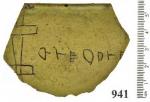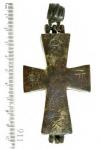Summary (English)
KASTRITSI FORTRESS (Valentin Pletnyov, Maria Manolova-Voikova – mara_manolova@yahoo.de, Igor Lazarenko) Two buildings, each one consisting of two rooms and discovered in 2012, were completely excavated. Part of the northern street, which began from a small square and was leading to the east, was explored. Four Mediaeval buildings were explored, each one consisting of one or two rooms. The buildings adjoined the fortification wall and their entrances were towards the northern street. Two of the buildings were constructed over the ruins of a building of the 6th century AD. Two Mediaeval buildings and part of the southern street located in the central part of the fortress were discovered. The walls of the buildings were 60 – 80 cm wide, constructed of cut stones bonded with mud. Collapsed burned timber beams and fragmentary wattle-and-daub were discovered in some of the buildings. All buildings and streets were reconstructed and had two levels, which confirmed the hypothesis that an earthquake occurred c. 1350. The finds from both construction levels were identical: sherds and coins from the middle and the second half of the 14th century. The presence of significant number of copper mangir and silver akçe of Sultans Murad I and Bayezid I in the upper occupation layers, mixed with coins of the Bulgarian Kings Ivan Alexander and Ivan Shishman, the Despot of Dobrudzha Dobrotitsa, Mircea I of Wallachia and Vlad I the Usurper, indicated that the reconstruction of the buildings occurred during the second half of the 14th century. The finds from the excavations included four crosses-encolpia, bronze belt buckles, exagia, Late Antique terracotta lamps, copper lamps of the 14th century, sherds from sgraffito pottery, some of them with monograms that read: Demetrios, a sherd from a cup with an inscription that reads: О ГЕОРГЕ, the base of a proto-maiolica dish produced in Southern Italy, shovels, spatulas, knives with bone handles, arrowheads and 445 coins: 31 Roman and Late Antique minted from Caracalla to Arcadius, 29 Early Byzantine minted from Anastasius I Dicorus to Heraclius, seven Byzantine: two anonymous folles of the Class A2 and the Class B and five minted by the Palaeologian Dynasty during the 14th century, 37 Bulgarian minted by the Kings Theodor Svetoslav, Michael III Shishman, Ivan Alexander and a silver grosso of Ivan Sratsimir, five copper coins of the Despot of Dobrudzha Dobrotitsa minted in Kaliakra and Drastar, 156 Wallachian, including three hoards (21 silver grossi of Mircea I of Wallachia, 130 billon coins of Mircea I of Wallachia and Vlad I the Usurper, six silver ducats of Mircea I of Wallachia), a copper coin of Pisa of the 14th century, five Tatar coins, 62 copper mangir and several silver akçe of Sultans Murad I and Bayezid I and Emir Suleiman (minted up to 1410).
- Valentin Pletnyov - Regional Museum of History – Varna
- Maria Manolova-Voikova - Regional Museum of History – Varna
- Igor Lazarenko - Regional Museum of History – Varna
Director
Team
Research Body
- Regional Museum of History - Varna






![Download [PDF]](/excavation/skins/fasti/images/results/download_sml.png)

